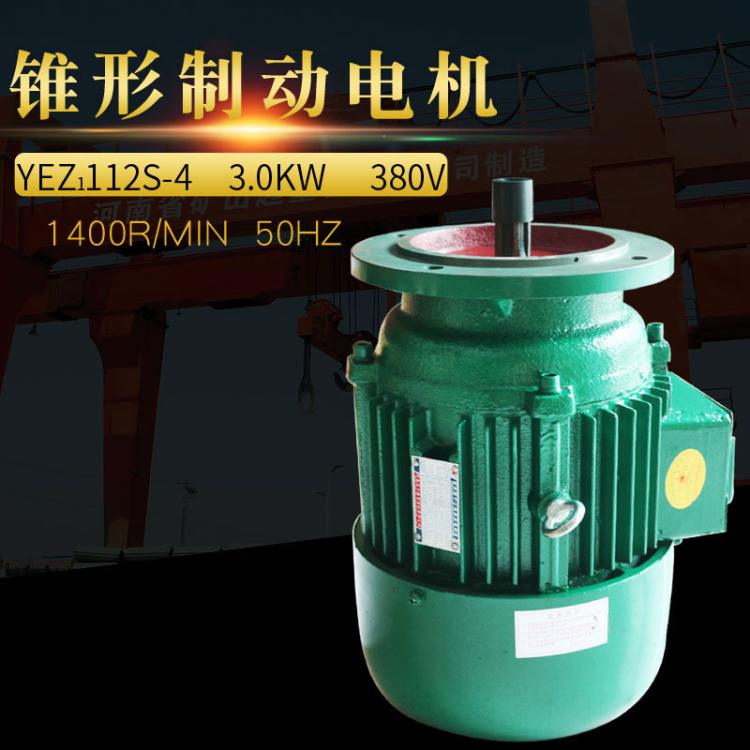Introduction to Cone Motor:
以下是关于锥形电机的介绍:
- 结构组成:主要由定子、锥形转子、压缩弹簧、前盖、后盖、风扇制动轮、制动环等组成。定子通常采用三相绕组结构,由铁芯和线圈组成,铁芯为锥形,线圈固定其上;转子一般为永磁体结构,呈截锥形,在两端伸出小直径端和大直径端转子转轴。
- 工作原理:定子通以三相交流电后,产生旋转磁场和轴向磁拉力。在轴向磁拉力作用下,电机转子克服弹簧压力,使风扇制动轮上的制动环脱开后端盖,电机便旋转。断电时轴向磁拉力消失,在弹簧压力作用下,制动轮刹紧后端盖实现制动。
- 型号表示:如ZDY11-4 0.8KW,ZD、ZDY代表锥形转子制动三相异步电动机,***位数字代表机座号,第二位数字代表铁心长度,第三位数字代表电机极数,第四位数字代表电机功率(KW)。
- 应用领域:广泛应用于电动葫芦、卷扬机等起重设备,以及机械制造、冶金、化工、建筑、轻工、电力等行业的起重机、输送机、冷却塔、风机、泵站等机械设备,可实现减速、制动和定位等功能。
- 常见故障及原因
- 绕组严重过热:定、转子间气隙过大,使空载电流增大;定子偏心使电机运转轻摩擦。
- 电机起动困难或带负载时转速较额定值低:空载时起动困难可能是制动环与刹车面锈死、电源电缆线太细、弹簧压力过大或转子与定子铁芯运转时相擦等原因导致;负载时起动困难或转速低可能是电机负载过大、起动转矩过低或转子导条有裂纹或端环开裂等原因引起。
- 电机制动下滑:制动环磨损致使制动轮与刹车面间隙过大;弹簧压力过小或压力弹簧疲劳;制动环松动、受潮或有油污等。
The following is an introduction to conical motors:
-Structural composition: mainly composed of stator, conical rotor, compression spring, front cover, rear cover, fan brake wheel, brake ring, etc. The stator usually adopts a three-phase winding structure, consisting of an iron core and a coil. The iron core is conical and the coil is fixed on it; The rotor is generally a permanent magnet structure with a truncated cone shape, and the rotor shaft extends from the small diameter end and the large diameter end at both ends.
-Working principle: When the stator is supplied with three-phase AC power, it generates a rotating magnetic field and axial magnetic pulling force. Under the action of axial magnetic tension, the motor rotor overcomes the spring pressure, causing the brake ring on the fan brake wheel to detach from the rear cover, and the motor rotates. When the power is cut off, the axial magnetic pulling force disappears, and under the action of spring pressure, the brake wheel tightens the rear cover to achieve braking.
-Model representation: For example, ZDY11-4 0.8KW, ZD and ZDY represent cone-shaped rotor brake three-phase asynchronous motors, the first digit represents the machine base number, the second digit represents the iron core length, the third digit represents the number of motor poles, and the fourth digit represents the motor power (KW).
-Application areas: Widely used in lifting equipment such as electric hoists and winches, as well as mechanical equipment such as cranes, conveyors, cooling towers, fans, and pump stations in industries such as machinery manufacturing, metallurgy, chemical engineering, construction, light industry, and power. It can achieve functions such as deceleration, braking, and positioning.
-Common faults and causes
-Serious overheating of the winding: the air gap between the stator and rotor is too large, which increases the no-load current; The eccentricity of the stator causes light friction during the operation of the motor.
-Difficulty in starting the motor or when the speed is lower than the rated value under load: Difficulty in starting under no-load conditions may be caused by rust on the brake ring and brake surface, thin power cables, excessive spring pressure, or friction between the rotor and stator core during operation; Difficulty starting or low speed under load may be caused by excessive motor load, low starting torque, or cracks in rotor guide bars or end rings.
-Motor brake sliding: The wear of the brake ring causes excessive clearance between the brake wheel and the brake surface; The spring pressure is too low or the pressure spring is fatigued; The brake ring is loose, damp, or has oil stains.










